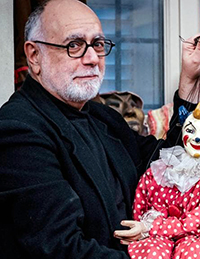The message for the Commedia dell'Arte Day
Alfonso Cipolla

Dedication by Alfonso Cipolla
Commedia dell'arte remains a mystery to me. Or rather, what the art of comedians was supposed to be remains a mystery.
Entire libraries were written on improvised comedy: collections of scenarios, mottos, treatises, iconographic repertoires, conjectures, reconstructions, analyses... And outside the pages of the books, on the stage, the proponents of that ancient wisdom distilled techniques and codifications. But - because the but remains - if I want to listen to their heart, figuring how those actors really acted remains for me a nebula that only the most ancient memories attempt to clear up. Luck and an unfortunately inclement civil registry have made me meet, in times long gone, exceptional actors, the last survivors of a breed born on the stage and not in the academies. I think at the actors of Neapolitan farces, at the “buskers” of the square, at the comedians and fantasists of the Variety, at the free-range puppeteers born in the arts who knew dozens of comedies by heart without ever having read even one. Acting without acting, pretending without pretending and yet being and not being at the same time, still remaining oneself while performing characters. Extraordinary actors, in fact, who knew how to have the audience eat from their hands, dominating it.
Were those comedians perhaps a bit of all this? Probably, but it's not certain.
Certainly they were professional actors, or rather inventors of their own profession, which was treated as a "profession", like any other craftsman. Every time that, in long gone years, I spoke with some elderly son of an artist, the recurring statement was always more or less the same: "It was done just to live". Art, as we understand it by distorting it, was a completely different thing for them, in fact it wasn't even contemplated. It was the needs of the profession that shaped the profession, that identified strategies to be able to "live" doing that job, building styles, dramaturgy, virtuosity functional to the practicality of doing. The result - a distillation of experiences - is the development of a universal scenic language in its immediacy, such that it can break down every barrier: social, cultural, linguistic. This is the true strength of commedia dell'arte which offers us essential principles that go beyond the codification of models, which are projected into our contemporary world, reminding us (and this is its true legacy) that theater is community and inclusion: too many words today, sometimes abused, but it is pride and due necessity to safeguard them, without showing them off.
Alfonso Cipolla
President of the Institute for Puppetry Heritage and Popular Theater and of UNIMA Italia
Short Biography
Professor of Theory and Technique of Scenic Interpretation at the “G. Cantelli” Conservatory of Music in Novara, he taught Animation Theater for ten years at the Faculty of Letters and Philosophy of the University of Turin. In 2001 he founded with Giovanni Moretti the Institute for Marionette Heritage and Popular Theater of which he is director, curating numerous projects, exhibitions and publications. Since 2020 he has been president of the UNIMA National Center (Union Internationale de la Marionnette). For forty years he has been a theater critic, first for the «Gazzetta del Popolo», then for «Stampa Sera», and then since 1996 for «La Repubblica».

